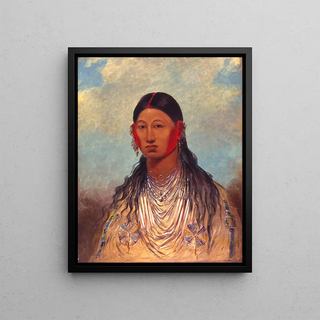War female eagle Koonzayame - George Catlin art print


View from behind

Frame (optional)
George Catlin’s "Female War Eagle Koonzayame" is a captivating testament to the intersection of art and Native American culture. Through this painting, Catlin immerses us in the world of North American indigenous tribes, capturing not only the majestic beauty of the eagle but also its symbolic and spiritual significance. As a witness and advocate for indigenous cultures, the artist invites us to reflect on the profound relationship between humans and nature. This art print of the iconic work offers an entry point into a bygone era, while allowing us to appreciate the finesse and depth of Catlin’s artistic vision.
Style and uniqueness of the work
The aesthetic of "Female War Eagle Koonzayame" is characterized by striking realism, a hallmark of Catlin’s craftsmanship. The artist excels in depicting details, whether in the eagle’s plumage or in the natural elements surrounding it. The vivid colors and powerful contrasts bring the scene to life, creating an atmosphere that is both dynamic and serene. Catlin manages to transcend the simple representation of the animal to make it a symbol of strength and dignity, embodying the values of the peoples he encountered. This piece is much more than a mere painting: it is a tribute to the grandeur of wildlife and the spirituality that surrounds it, uniting art and nature in perfect harmony.
The artist and his influence
George Catlin, 19th-century painter and ethnographer, is often regarded as one of the first artists to systematically document Native American cultures. Traveling across plains and mountains, he sought to capture daily life, rituals, and traditions of the tribes he met. His work is marked by deep empathy and respect for indigenous peoples, whom he often defended against colonial expansion. Catlin succeeded in raising awareness of the cultural richness of these societies, and his legacy endures through his paintings, which continue

Matte finish

View from behind

Frame (optional)
George Catlin’s "Female War Eagle Koonzayame" is a captivating testament to the intersection of art and Native American culture. Through this painting, Catlin immerses us in the world of North American indigenous tribes, capturing not only the majestic beauty of the eagle but also its symbolic and spiritual significance. As a witness and advocate for indigenous cultures, the artist invites us to reflect on the profound relationship between humans and nature. This art print of the iconic work offers an entry point into a bygone era, while allowing us to appreciate the finesse and depth of Catlin’s artistic vision.
Style and uniqueness of the work
The aesthetic of "Female War Eagle Koonzayame" is characterized by striking realism, a hallmark of Catlin’s craftsmanship. The artist excels in depicting details, whether in the eagle’s plumage or in the natural elements surrounding it. The vivid colors and powerful contrasts bring the scene to life, creating an atmosphere that is both dynamic and serene. Catlin manages to transcend the simple representation of the animal to make it a symbol of strength and dignity, embodying the values of the peoples he encountered. This piece is much more than a mere painting: it is a tribute to the grandeur of wildlife and the spirituality that surrounds it, uniting art and nature in perfect harmony.
The artist and his influence
George Catlin, 19th-century painter and ethnographer, is often regarded as one of the first artists to systematically document Native American cultures. Traveling across plains and mountains, he sought to capture daily life, rituals, and traditions of the tribes he met. His work is marked by deep empathy and respect for indigenous peoples, whom he often defended against colonial expansion. Catlin succeeded in raising awareness of the cultural richness of these societies, and his legacy endures through his paintings, which continue






